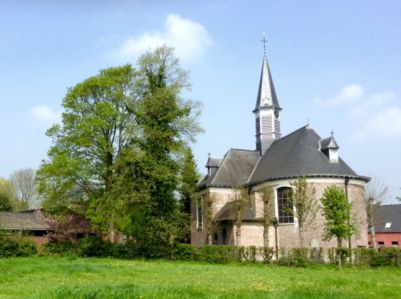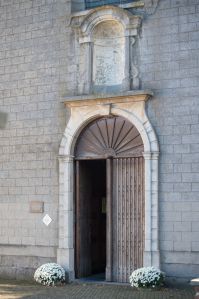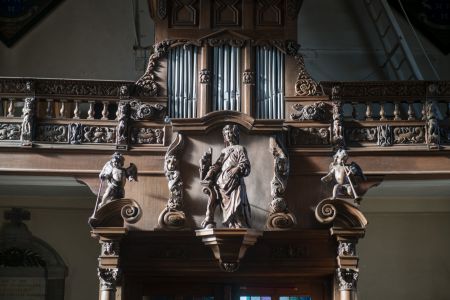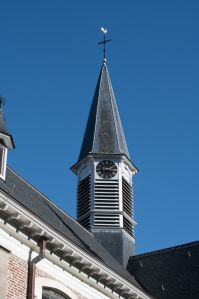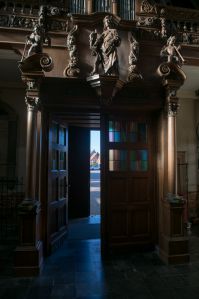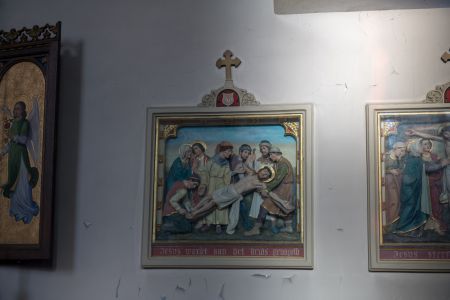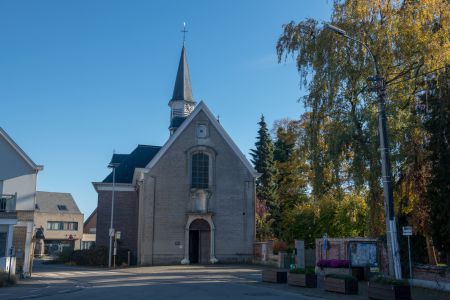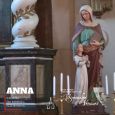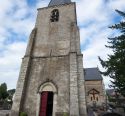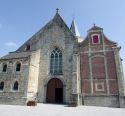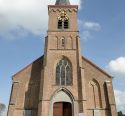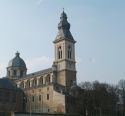Church | 1750 | | Catholic Church


Map
Opening hours
01 January - 31 December
Mon 9.00 - 16.00
Tue 9.00 - 16.00
Wed 9.00 - 16.00
Thu 9.00 - 16.00
Fri 9.00 - 16.00
Sat 9.00 - 16.00
Sun 9.00 - 16.00
Description
This is a listed building in possibly one of the oldest parts of Wetteren, right in the village centre between the statue of the Sacred Heart, the parish hall and the former vicarage.
It is bordered by the river is Scheldt, north the village of Laarne and west an old riverbed, separating it from the villages Melle and Heusden. At one time the area could only be reached by ferry over the Scheldt, completely isolated during stormy weather.
As the population increased, the need for a local place of worship grew because the nearest church was about 2 hours away.
Between 1750 and 1753 the present church was built. It is a simple rural church with one aisle, transept and a semi-circle chancel. It has a sober bell tower (1892). The entrance is via classisistic portal altars.
The main feature in this church is the listed organ, dating from 1750. It probably comes from the Baudelo abbey in Ghent that was occupied by French troops at the end of the 18th century. The oak carvings around the organ may be older as the date 1606 on the organ case testifies.
Other features are the paintings from the Flemish School, Stations of the Cross by Alois de Beule and the 17th century altar cloths with dedications to St. Anthony of Padua an the Holy Mary.
The church is surrounded by greenery and borders a horse meadow. It is also the starting point or focal point of several hiking, running and cycling trails.
1. Cycling trail Scheldeland, tourism Flanders, signs 28 and 66.
2. Running circuit trail Wetteren-Ten-Ede.
3. Hiking trail Papullen path.
The church can be reached by public transport (call bus 140 and autobus).
KIKIRPA : Photo-library online
More information on this church :
Gemeente Wetteren
Parochie Laarne-Wetteren
Photos
Remarkable elements
Organ
Probably from the 18th century. The maker is unknown. The wooden carving around the organ is older (inscription 1666). According to oral tradition, during the French occupation in the 18th century, the organ was removed from the Baudeloo abbey in Ghent. It is a fact that organ builder Pieter Van Peteghem built an organ for the Baudeloo abbey in 1763.
Stations of the Cross
14 Stations of the Cross built in 1902 by Alois De Beule in plaster relief panels, incorporated in the north and south sides of the nave.
High choir
The main altar is a portico altar from the 2nd half of the 18th century. The maker is unknown. It is partly made of stone, wood and plaster. Above the columns are 2 fire cups, the Lamb in the centre of a sealed book and the Eye of God in a ray wreath. The altar painting is an oil on canvas by an unknown master from the beginning of the 19th century, dedicated to Saint Anne the patron saint of the church. The work depicts "The upbringing of Our Lady, Saint Anne teaches Mary to read". Further on in the high choir is also a wooden polychromed statue of St. Anne, from the 19th /20th century. Here too the artist is unknown.
Traduit avec www.DeepL.com/Translator
Southern transept
Transept sud avec autel à portique datant du 3ème quart du 18ème siècle. Le constructeur est inconnu. C'est en bois avec en haut le buste de saint Antoine de Padoue auquel est dédié l'autel (le "2e" saint patron de l'église). La peinture de l'autel date de la même époque et représente "L'apparition de l'enfant Jésus à saint Antoine". Au-dessus du confessionnal se trouve le tableau du XVIIe siècle représentant "Saint François recevant l'enfant Jésus des mains de Notre Dame". Les deux tableaux sont des huiles sur toile de maîtres inconnus. Sur un pilier de célébration, il montre la remarquable statue de Saint Nicolas de Tolentino avec du bétail.
North transept
Northern transept with portico altar of the same style as and maker of the altar in the southern transept. The two altars were built together. The altar is dedicated to Our Lady, whose bust can also be seen at the top of the altar. The altar painting represents "Our Lady with Child, glorified by Angels". Above the confessional hangs the painting "The Meal in Emmaus" from the 17th century. To the left of the window is the painting "Education of Our Lady" from the 17th century, to the right "The announcement to Mary" from the 16th century. The last painting is an oil on panel, the others are oil on canvas. Not a single artist is known.
Pulpit
The first entrance was through the sacristy. The oak furniture decorated with heavy mouldings and simple carvings dates from 1750 to 1800. The maker is unknown.



